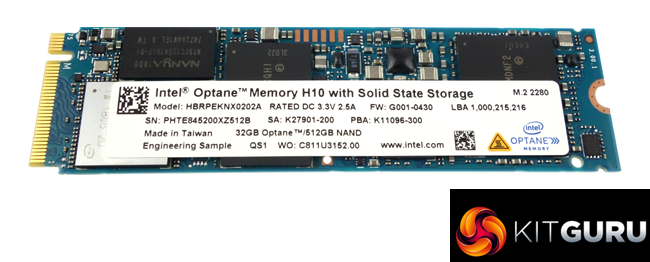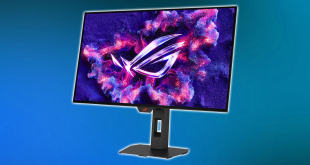Intel announced the Intel Optane Memory H10 at the beginning of 2019 at CES and it heralds a new line of products from Intel, combining the low queue depth performance of Optane's 3D Xpoint memory with the higher capacity and much cheaper NAND flash memory. In the case of the H10, that means QLC (quad-level cell) NAND.

In its first incarnation Intel's Optane Memory was rolled out as very small SSD's used as SSD cache devices to boost the performance of slower SATA based drives in a system. With the H10 this idea has developed so now both the Optane memory and the standard NAND are both installed on the same M.2 format PCB.
Although the H10 uses a PCIe x4 interface, the four PCIe lanes are split between the two sets of major components on the PCB because basically the H10 is two drives sitting on one PCB. The Optane memory drive uses an Intel SLL3D controller and 128Gb 3D XPoint memory while the standard QLC NAND is looked after by a Silicon Motion SM2263 controller.
Making sure that everything works smoothly is Intel's Rapid Storage Technology (RST) caching software and drive suite. When it comes to compatibility, Intel state that the Optane Memory H10 only works in Windows 10 64-bit systems using 8th and 9th generation Intel processors and chipsets. Also any motherboard BIOS needs to fully support Optane memory.
Intel quote Sequential performance for the 512GB H10 as up to 2,300MB/s for reads and up to 1,300MB/s for writes, figures we could confirm with testing. The review sample produced a read score of 2,485.6MB/s with writes at 1,231.8MB/s.
Intel's Optane technology is designed to offer the best performance, particularly reads, at low latencies and queue depths where the vast majority of everyday workloads occur. We could confirm this with the 4K CrystalDiskMark tests. At a queue depth of 1, the H10 produced a random read score of 193.6MB which completely outclassed the Intel SSD 760p drive using standard NAND which gave a score of 55.06MB/s. However deepening the queue depth to 32 saw the results switch, with the SSD760p (618.4MB/s) read performance trouncing the H10's 405.4MB/s.
While the Optane Memory H10 showed some real potential, hopefully it will lead to a drive that uses a single controller to look after both Optane and NAND technologies without having to split up PCIe lanes.
At the time of writing this review you can't buy the Optane Memory H10 in the retail sector as it's a OEM part but time will tell if Intel decide to launch retail versions of it.
Pro
- Caching technology works well.
- Easy to set-up.
Cons
- OEM part only at present.
- Only works with 8th and 9th generation Intel processors and chipsets.
- 1TB maximum capacity.
Kitguru says: The Intel Optane Memory H10 worked well and showed impressive performance when multitasking real-world applications.
 KitGuru KitGuru.net – Tech News | Hardware News | Hardware Reviews | IOS | Mobile | Gaming | Graphics Cards
KitGuru KitGuru.net – Tech News | Hardware News | Hardware Reviews | IOS | Mobile | Gaming | Graphics Cards



